|
|
|||
|
(Back to Preceding Week; on to Next Week) |
|
The Web site for Hilton Pond Center for Piedmont Natural History went live on Groundhog Day 2000 with the first installment of "This Week at Hilton Pond." Our first posting included a Woodchuck cartoon and stated simply that the site "saw its shadow but--unlike groundhog weather maven Punxsutawney Phil--it WILL be staying up for the remaining six weeks of winter, and for a long time thereafter!" Happy Tenth Anniversary to US, and |
|
THE 20-TENNERS IN COSTA RICA:
Our tenth expedition to study and band Ruby-throated Hummingbirds in Costa Rica began VERY early on 26 January 2010 as we departed Hilton Pond Center in the middle of the night for a 6 a.m. flight out of Charlotte. Check-in went smoothly at what we view as one of the nation's most passenger-friendly airports.
All text, charts, maps & photos © Hilton Pond Center Following a painfully slow three-hour-plus drive up the Pan American Highway we arrived after dark in the provincial capital of Liberia and checked in at Hotel Aserradero (above), a simple but adequate inn named for the sawmill that once stood nearby. (Aserradero has clean rooms, comfy beds, hot showers, low rates, access to local restaurants, and a few flowering Aloe Vera plants in the backyard. What more could one ask?) After freshening up, we went out for a supper of camarones--delicious jumbo shrimp that are a staple in this region--and talked about plans for the next few days before our other trip participants were to fly in from the U.S. We decided to turn in early and get up early to scout our usual study areas for hummingbirds. All text, charts, maps & photos © Hilton Pond Center PRELIMINARY WORK (27 Jan-1 Feb), Omega Group:
All text, charts, maps & photos © Hilton Pond Center The "Omega Group" (AKA Bill Hilton Jr., Ernesto Carman Jr., and Ela Villanueva Mayorga) was up about dawn on 27 January, eager to visit the Aloe Vera fields around Liberia that had proved so valuable in past years as places where wintering Ruby-throated Hummingbirds (RTHU) congregate. After a quick "typical" breakfast--including black beans and rice, of course--the group drove about ten miles north to Cañas Dulces, a small town a few miles east of the Pan American Highway. Our first stop was at Aloe Vera Field #1 (AV1), the only one on the north side of the road. We weren't surprised to find AV1 filled with weeds so tall and dense we could barely find the two-foot-tall aloe plants (foreground, above); we also couldn't see any four-foot stalks of yellow, nectar-rich aloe flowers so attractive to RTHU. AV1 had always been a marginal field for aloe and we hadn't actually caught any RTHU there, so after finding no aloe blossoms and no hummingbirds we traveled on without much concern.
All text, charts, maps & photos © Hilton Pond Center A right turn on the town's outskirts took us across a rickety bridge over a stagnant stream, past the site of a once-famous Jocote tree, and down a bumpy, dusty road that led to the main sections of an 80-acre aloe plantation where we'd banded about 400 ruby-throats through the years. Opening a barbed wire gate allowed us to access AV2, the first in a long, linear series of irregularly shaped aloe fields. (The GoogleEarth photo above shows several aloe plots. Dots with dates are locations where a banding table was situated during given years.) To be honest, AV2 looked even worse than AV1, with not only weeds but early successional shrubs and trees sprouting among the aloe. Again, we weren't too concerned; we hadn't worked AV2 since 2006 and historically productive fields still lay ahead.
All text, charts, maps & photos © Hilton Pond Center As we drove past each successive field we became less and less optimistic. AV3 looked about like AV2, as did AV4 and AV5--fields in which mist nets had snared many hummers during the past three years of work. All this weediness and scarcity of hummer-attracting aloe flowers did not bode well--and neither did the fact that aloe plants in AV6 had been uprooted and replaced with a watermelon patch! To survey the situation, the Omega Group climbed steep steps leading to the top of Little Sugarloaf, a rocky outcropping that allowed us to oversee nearly the entire aloe plantation (above). From a scenic point of view the panorama was idyllic, but through the eyes of hummer-hungry researchers it was not a pretty sight. Rows of aloe were faintly discernible in AV5-North (lower right in photo above), but in the main parts of AV5 (center) and AV4 (upper right) weeds had taken over and very few yellow flower stalks could be seen. We weren't too keen on those lush new watermelon plantings in AV6, either.
All text, charts, maps & photos © Hilton Pond Center Atop Little Sugarloaf, when we turned 180 degrees and faced east we could see AV7 (above) which wasn't quite as weed-ridden; nonetheless, it also had almost no aloe flowers, so with considerable concern the Omega Group climbed back down to the car. After all, our next bunch of citizen scientists from the U.S. would be coming in just a week and it didn't appear the Aloe Vera plantation at Cañas Dulces was going to be a very good place to catch hummingbirds.
All text, charts, maps & photos © Hilton Pond Center An aloe bloom failure at Cañas Dulces coud have been devastating, but the Omega Group still had an ace up its collective sleeve. Last year we had "discovered" another Aloe Vera plantation a few miles south of Liberia behind the Carrington Industries' aloe processing plant (above), right on the Pan American Highway. This farm, then called Finca Sabila, was exceptionally lush and turned out to be a lifesaver in 2009 when fields at Cañas Dulces were less productive than usual. Ironically, Carrington closed their plant last February for undisclosed financial reasons and we feared this "new" aloe farm would not be cared for, but by midsummer a rice company called Pelón de la Bajura purchased the facility. This year Ernesto visited the Carrington/Pelón fields in early January while guiding another bird tour. At that time--three weeks before our 2010 arrival--aloe plants were starting to send up flower stalks, so he speculated yellow blooms should be appearing by now. With that knowledge in mind, we headed back south to inspect the Pelón facility. Imagine our surprise when the first aloe plot we encountered DID have flower stalks but they bore NO flowers. It turns out Pelón's new management believes blossoms rob energy from aloe plants whose leaves are harvested for juice, so workers are instructed to remove flower clusters! Needless to say, snipping blooms off the aloe doesn't do much to attract nectar-seeking hummingbirds.
All text, charts, maps & photos © Hilton Pond Center Fortunately, field hands had removed flowers from only one of Pelón's plots, leaving the rest as they worked instead on breaking off aloe "pups" and transplanting them in a fallow field on the far side of the finca. Even so, as shown in the photo above the uncut fields weren't nearly as flower-laden as last year when they were a veritable "sea of yellow." Still, there were LOTS more flowers at Pelón than at Cañas Dulces, so the Omega Group decided this was probably the best place to try to catch hummers--at least for the next several days.
All text, charts, maps & photos © Hilton Pond Center With a few Ruby-throated Hummingbirds buzzing overhead in trees near the Pelón processing plant (at right in photo above), the Omega Group surveyed net lanes on a berm created when a drainage ditch was dug around the perimeter. This berm--at far left in the photo--was accessible by a narrow walking trail and elevated our nets so birds flying from aloe into surrounding woodland could not easily see the dark mesh against vegetation. Because this particular location proved quite productive in 2009--we caught 86 RTHU on six field days--the Omega Group was optimistic about our chances in 2010. Thus, we spent the rest of 27 January clearing weedy brush and re-establishing old net lanes we would use the next day.
Each hummer we banded at Pelón also got two horizontal blue marks on its chest and throat (right) to allow us to observe its behavior after release. This temporary dye fades out within a few weeks under harsh rays of the tropical sun, so it's unlikely anyone in North America will ever see one of our blue-marked birds from Costa Rica. (NOTE: This spring there IS a possibility folks north of York SC might spot a GREEN-marked RTHU we've banded at Hilton Pond Center.) On 28 January we also netted and banded a Yellow Warbler and three Orchard Orioles--all males (two after-second-year and one second-year).
All text, charts, maps & photos © Hilton Pond Center On the afternoon of 28 January we decided to drive south to Palo Verde, a 32,000-acre preserve that encompasses vast wetlands along the Tempisque River on the north end of the Gulf of Nicoya. (NOTE: Cattle and horses grazing in the photo above are there to keep cattails from overtaking the marsh.) Last November while banding birds at Hilton Pond Center in York SC, we got a long distance cell phone call from Ernesto--who happened to be standing on a boardwalk (above) near the Organization for Tropical Studies (OTS) biological station at Palo Verde National Park. Ernesto was noticeably energized and wanted us to know he was looking at quite a few Ruby-throated Hummingbirds feeding on emergent aquatic flowers and in trees and shrubs around the marsh. He thought it would be quite easy to run mist nets on the boardwalk or along the wetland edge and that such an effort would yield lots of ruby-throats. There were still a few RTHU at Palo Verde during our January visit, but it appears October-November would be a better time for banding. To this end, we've applied for a grant in support of an Autumn 2010 trip to Costa Rica, and we're waiting for a response.
All text, charts, maps & photos © Hilton Pond Center Like the day before, on 29 January we were on-site early at Pelón and had our first RTHU by 6:25 a.m. Things improved slightly with a total of seven ruby-throats banded by noon--again all females--plus two more Yellow Warblers, a Tennessee Warbler, and a second-year female Baltimore Oriole (above). We also re-netted one blue-throated RTHU from the preceding day, but of far greater interest was an UNMARKED adult male Ruby-throated Hummingbird with a red throat and an older band on its leg that read C51843.
All text, charts, maps & photos © Hilton Pond Center A quick records check revealed this ruby-throat had been captured by last year's Beta-Niner group and banded as an "after-hatch-year" male at the Pelón site (formerly Carrington) on 8 February 2008--almost 12 months previously. This bird (above) was cause for great jubilation because it was only the fourth time a Ruby-throated Hummingbird banded in the Neotropics returned in a later year and was recaptured. We were first to document such RTHU site fidelity on Neotropical wintering grounds at the Cañas Dulces site in 2007 and 2008, but this particular bird was banded at and returned to Pelón--indicating winter faithfulness for two different Costa Rican locations. Even now--after almost three decades of studying hummingbirds--it's hard for us to comprehend how a tiny bird the size of one's thumb can migrate all the way to North America and then return to the exact same spot in Central America six months later. (NOTE: We were particularly intrigued at how worn the gorget feathers were on C51843; see photo above. This is not something one finds on adult males when they're in North America.) Our efforts at Pelón on 30 January were similar to those of the two preceding days: First RTHU banding at 6:30 a.m., with a total of seven hummers--once again all females--by noon. We recaptured a ruby-throat we banded 24 hours earlier but had no previous-year returns and did not net any other Neotropical species.
All text, charts, maps & photos © Hilton Pond Center Things were quite slow at Pelón on 31 January, with just four early morning RTHU captured--all females. It turns out we were done for the day by 7:35 a.m., even though nets were open for another 4.5 hours. With all that idle time on our hands, the Omega Group got to make extensive observations of birds and plants along the net lanes. In particular, hummingbirds, orioles, and warblers all seemed to be spending much less time in the aloe than they did among showy pink flowers of the leguminous Madero Negro tree, Gliricidia sepium (above, with female RTHU).
All text, charts, maps & photos © Hilton Pond Center Despite some treetop foraging activity, our consensus was there were MANY fewer birds in the area this year than last, not only ruby-throats but also Orchard Orioles, Tennessee Warblers, Indigo Buntings, and Blue Grosbeaks that had been quite common in 2009. A few Baltimore Orioles could be seen taking nectar from aloe flowers (above), but things just weren't the same. We surmised some possible factors for reduced bird numbers at Pelón this year compared to 2009: 1) With purchase of the aloe fields by Pelón, renewed human activity was spooking the birds and sending them elsewhere; 2) A widespread brushfire in recent months on the wooded area outside the perimeter of the Pelón fields eliminated many native plants that would have been sources of shelter and nectar; 3) We were observing some cyclic but unknown aspect of Neotropical bird populations; or 4) Another disruptive event (or events) had occurred within the birds' breeding range, along their migratory route, or on the wintering grounds. In any case, it's all speculation as to why observations of ALL Neotropical bird species at Pelón were far fewer this year than last. (Ela jokingly suggested the Omega Group simply had "bad juju," which may have been as good an explanation as any.)
Results of the Omega Group's preliminary banding efforts at Pelón yielded the results in Table 1 (above). After our four days in the field, the real question might be: "Where the heck were all the male ruby-throats?" With the exception of the one returning male from last year, all 23 RTHU captured at Pelón were female. (More about this later.) On 1 February the Omega Group took time off from banding to rest, deal with logistics, check out of Hotel Aserradero, move up to Buena Vista Lodge 15 miles distant, and prepare for the next-day arrival of our citizen scientists from the U.S. Based on the lack of aloe flowers at Cañas Dulces and despite low activity at Pelón, it looked like this year's group would be trying to catch hummingbirds on Pelón's perimeter trail. All text, charts, maps & photos © Hilton Pond Center DAY ONE (2 Feb), 20-TENNERS:
Had Punxsutawney Phil been in western Costa Rica on 2 February this year, his shadow forecast would have been invalidated; Guanacaste Province was experiencing anything but winter weather with clear skies and afternoon temperatures in the middle-90s. The usual gusty winds didn't stop airplanes from landing at Liberia's airport, where the Omega Group waited to meet our newest Operation RubyThroat citizen science group from the U.S.
All text, charts, maps & photos © Hilton Pond Center Arriving were Wisconsin brothers Ken and Levi Wood (Black Earth and Madison, respectively, above left and right), sisters Anne Fuller (Juneau AK, above center) and Abigail Cooke (Gig Harbor WA), Pat Barker (Charleston WV), and Brenda Piper (Middleton MA). These folks had come to Costa Rica to help with our study of Ruby-throated Hummingbirds in the Neotropics and, not coincidentally, to help underwrite our costs for that work.
All text, charts, maps & photos © Hilton Pond Center After initial introductions, we hustled the group's baggage into a waiting bus driven by Dago Vitratur, a Costa Rican driver with whom we worked for the first time this year. Dago (pronounced "Doggo")--likely wondering what our hummingbird group was all about--headed his air-conditioned 20-passenger bus for Laurel House Restaurant near the airport for the group's first taste of traditional Costa Rican food. This open-air establishment offers weary travelers exceptional service and very good meals--including the fresh fruit juice and "Volcano Rice" enjoyed by Abigail Cooke (above.) Notice the carrot-strip lava? Upon finishing lunch we boarded the bus again, headed east, turned north on the Pan American Highway at Liberia, and then back east again on the some-up-some-down, sometimes-smooth-sometimes-bumpy road through Cañas Dulces to Buena Vista Lodge on the slope of Rincón de la Vieja volcano--home away from home for the 2010 expedition. Everyone checked in to their cabins at the Lodge; gathered that evening for sunset, supper, and an instructional presentation; and finally headed off for bed. As is our custom, we provided the 2010 group with a nickname to help remind us what year they participated. We dubbed them the "20-Tenners." DAY TWO (3 Feb), 20-TENNERS: Ernesto, among other things our "living alarm clock" in Costa Rica, rapped on doors at 5 a.m. on 3 February and everyone was at breakfast before 5:30. (We're grateful the Buena Vista kitchen staff gets up early just for us when Operation RubyThroat is in town.) Amazingly, all six 20-Tenners were aboard the bus by 5:53 a.m.--a new record for earliness for our groups--and we were quickly on our way down the mountain toward Liberia. We paused briefly for a few bird sightings, but our main objective was to get to the Pelón study site as soon as possible. Arriving at about 7 a.m., the 20-Tenners took advantage of net lanes re-established the week before by the Omega Group, and they quickly learned how to properly unfurl mist nets. At 8:10 a.m. they caught the first Ruby-throated Hummingbird--a female, of course--but ten minutes later one of the nets snared a second-year male hummer that was the first of his sex for the year. Three hours later we still had banded only these two RTHU, but it's always good to go slow on the first day to allow more one-on-one instructional time for participants. Trip leader Bill ran the banding table, Ernesto and Ela extricated birds from the nets, and the 20-Tenners recorded important observations about bird behavior in the aloe and perimeter woods.
All text, charts, maps & photos © Hilton Pond Center On the way back up the mountain we stopped at the Cañas Dulces aloe plantation, where the 20-Tenners got to see firsthand the scarcity of aloe flowers and how weedy the fields had become. Then, after lunch at Buena Vista Lodge, individuals in the group had the afternoon to themselves to explore or take a siesta. As always, at about 5:15 p.m. everyone gathered at Mirador ("lookout") to watch the sunset over Big Sugarloaf and the Pacific Ocean (above)--the latter about 20 miles away as the hummingbird flies. DAY THREE (4 Feb), 20-TENNERS: The 20-Tenners' second day at Pelón was almost as slow as the first, with only three ruby-throats--all females--banded in five hours. Non-hummers were more active, however, and we netted a Tennessee Warbler and two Yellow Warblers. Two other particularly colorful adult male Neotropical migrants also hit the nets and got bands--Baltimore Oriole and Painted Bunting. The big bonus came at 8:25 a.m. when Ela (nearly betrayed by her beautiful smile) brought in an UNMARKED female Ruby-throated Hummingbird with a band on its left leg; the number read C51792. On their second day in the field the 20-Tenners had netted another returning ruby-throat--one that had been banded at Pelón by the Beta-Niners almost exactly a year earlier on 2 February 2009! Counting the male caught by the Omega Group, that made two returns in 2010, and we were just getting started.
All text, charts, maps & photos © Hilton Pond Center On 4 February the group got to see and photograph their first Costa Rican resident birds, including an Inca Dove and an aptly named Rufous-naped Wren (above). The latter resembles the Carolina Wren that occurs across much of North America but is much larger, longer-billed, and with brighter field marks. Rufous-naped Wrens are absent from most of Costa Rica but nearly everywhere in Guanacaste; they're a social and very vocal local species.
All text, charts, maps & photos © Hilton Pond Center DAY FOUR (5 Feb), 20-TENNERS: Just when we thought things couldn't get much slower in Pelón's perimeter net lanes, on 5 February the 20-Tenners caught just one new Ruby-throated Hummingbird (a female). Incredibly, however, they also managed to net C51803 (above)--yet another female RTHU banded in 2009 at Pelón. Two returning ruby-throats on consecutive days, and both had been captured and released last year on 2 February by the Beta-Niners! That brought the number of returns this year to three, counting one the Omega Group had netted--pretty amazing when we'd only had three other returns in all the preceding expeditions. Looks like no one will ever be able to doubt site fidelity by ruby-throats in the Guanacaste aloe fields. Also on the banding table that day were a Tennessee Warbler and female Orchard Oriole.
All text, charts, maps & photos © Hilton Pond Center From the center of Santa Rosa we then traveled by bus to a very different place--the maritime forest at Junquillal Beach. At this marine sanctuary several 20-Tenners got their first up-close look at cold waters of the Pacific Ocean. Feeding in trees along the shore were everything from wild parakeet flocks to a tribe of White-faced Capuchin monkeys, and there were even a couple of Whimbrels probing the sandy beach for invertebrates. (Look for that shorebird just to the right of three 20-Tenners in the photo above). Having spent the last couple of hours in a dry tropical forest, it was quite a contrast for us to see Magnificent Frigatebirds and Brown Pelicans fishing salty waters in the bay.
All text, charts, maps & photos © Hilton Pond Center DAY FIVE (6 Feb), 20-TENNERS: After the Santa Rosa trip and three consecutive days of sweating in the heat around Pelón's aloe fields the 20-Tenners had the day off on 4 February. They got to sleep in and do whatever they wanted around Buena Vista Lodge, and four of them elected NOT to ride on horseback to the volcanic spa but to climb aboard a tractor-pulled cart instead (above). Word is they smeared each other with hot mud, but there seems to be no photographic evidence for how funny they looked adorned with icky stuff.
All text, charts, maps & photos © Hilton Pond Center Some of us who opted out of the spa trip spent the day watching birds and taking photos of local wildlife, including Groove-billed Anis (above) that foraged and perched among Buena Vista's trees. They hardly look it but these jet-black anis are in the Cuculidae, the Cuckoo Family, although some taxonomists put them in their own family, Crotophagidae. Like cuckoos, anis are zygodactylous--with each foot having two toes in front and two behind. (Songbirds have three in front, one in back.) Groove-billed Anis are highly social, living in groups of one to five breeding pairs that defend a territory and lay eggs in a communal nest in which each member helps incubate, brood, and feed the young. When captured in a mist net, they clamp down hard on one's fingers--something Ela has never let the slightly scarred and never-again-careless trip leader forget. DAY SIX (7 Feb), 20-TENNERS: Having rested up a bit on Hump Day, the 20-Tenners were eager to get back into the field to catch hummingbirds, so on 7 February we all went back down the mountain to Liberia and once again unfurled our nets around Pelón's perimeter. Perhaps a day off was a good idea in that we netted three Ruby-throated Hummingbirds between 7:20 and 9:18 a.m.; as usual, all were females. Unfortunately, the next 2.5 hours yield no hummers at all, but we did capture and band a Yellow Warbler and a female Orchard Oriole.
All text, charts, maps & photos © Hilton Pond Center Knowing it's impossible to legislate animal behavior and that sometimes when one goes fishing one doesn't catch any fish, the 20-Tenners weren't particularly disappointed that in almost 20 hours over four days at Pelón they had netted only nine Ruby-throated Hummingbirds. They were pleased to have captured two very exciting returns from 2009, and they had plenty of time to sit back and use binoculars to make all-important observations of hummingbird behavior (above), but we could tell they'd really like to repeat the successes of previous years by capturing lots more ruby-throats. Thus, after we closed the nets at Pelón and headed back up to Buena Vista Lodge for lunch, we stopped so we could talk with Franklin (below right), resident manager of the aloe fields at Cañas Dulces. With Ernesto translating, we queried Franklin further about the status of fields for which he was responsible and learned they had fallen into weediness after Carrington Laboratories closed their aloe processing plant at Liberia last year. Franklin, who with plantation owner Alfredo Oliva Véliz has always been highly supportive and proud of our efforts to study hummingbirds in the Cañas Dulces fields, expressed disappointment we had been forced to run nets at Pelón. He then mentioned--almost in passing--that during the past few days he had seen "lots of small hummingbirds" flying from aloe into surrounding woods and back again. When we asked him where, he described a small aloe field surrounded by forest--a plot at the far southeastern end of the Cañas Dulces plantation in a spot we had never visited and didn't even know about. With this news in mind, we re-boarded the bus but didn't tell the 20-Tenners what Franklin had said. Immediately after lunch the six 20-Tenners went off on their own to bird or take siestas, but the Omega Group covertly got into Ernesto's private car and drove back down the mountain as fast as was prudent. Our destination: The purported secret hummingbird-laden aloe field Franklin had described earlier. As we got to Cañas Dulces we entered the main aloe plantation and drove past those fields we had utilized in past years: AV2, AV3, AV4, and AV5--all of which were still pretty much full of weeds and devoid of aloe flowers. AV6 was now a watermelon patch, so we drove into AV7--a field the Omega Group had worked but that our citizen scientists had not entered because past drivers told us it was too hard to access via bus. AV7 was looking a bit better with some aloe flowers and blooms on several native plants such as Lantana, Blue Vervain, Turk's Cap Hibiscus, and an unnamed red scrophularian. A few ruby-throats were feeding, but rather than watch them the Omega Group continued on past AV8 and AV9, neither of which had many aloe flowers.
All text, charts, maps & photos © Hilton Pond Center Finally, up ahead we could see a gate through which we had never passed. Beyond the gate was a rocky downslope to a stream, then an even rockier upslope that suddenly flattened out and opened into a four-acre field (above). Just as Franklin had described it, the plot was surrounded by native trees and shrubs. There were also quite a few aloe flowers, and--most important--we saw bunches of Ruby-throated Hummingbirds buzzing about. Why, we felt as if we'd found Paradise! All text, charts, maps & photos © Hilton Pond Center Click on photo above to open a larger image in a new browser window Considering those four long, hot, minimally productive mornings at Pelón--where this year we'd banded just nine RTHU with the 20-Tenners and 23 with the Omega Group and NONE of those birds were males--we were flabbergasted to have three or four adult male ruby-throats in view at one time in this "new" field. We simply had to find a way to get the whole group back to this isolated site, known now as AV10--Aloe Vera Field #10--alias "Paradise." (See satellite photo above; access road is in red). Since it was still afternoon, the Omega Group (Bill, Ernesto, and Ela)--filled with excitement over the possibilities of AV10--decided to put up three mist nets to see if we could capture any afternoon birds. Sure enough, between 4:25 and 5:10 p.m. we captured and banded FIVE ruby-throats, including a partially gorgetted second-year male that was the first of his sex to be banded in 2010. We also netted another Yellow Warbler and female Orchard Oriole before closing our nets and heading back up to Buena Vista Lodge. When we were late for supper the 20-Tenners asked where we'd been, but the Omega Group was tight-lipped until the evening meeting when we were so excited about AV10 we could keep the secret no longer. The 20-Tenners got excited, too, over the prospect of running nets tomorrow and catching lots of hummers in "Paradise."
All text, charts, maps & photos © Hilton Pond Center DAY SEVEN (8 Feb), 20-TENNERS: Unbelievable as it might seem, Ernesto said he didn't have to knock on any cabin doors at 5 a.m. on 8 February; everyone was already up! The 20-Tenners apparently were eager to eat breakfast, board the bus, and head down to Cañas Dulces to see if our reports of Hummingbird Paradise were true. The previous night we had talked with driver Dago about AV10's relative inaccessibility and because he had become intensely interested in our hummingbird work he said he would give it a try with the bus. Imagine his surprise and our disappointment when our trip into the aloe plantation was halted by a large rock wedged between the hind wheels (above)--on a stretch of road that wasn't particularly difficult and over which we had ridden a bus many times! It took about 40 minutes for Dago and Ernesto to loosen the outer wheel far enough to dislodge the rock and until the 20-Tenners--practically quaking with anticipation--were back on board and heading deeper into the plantation. We were all elated when Dago's bus was able to ford several streams, navigate washed out sections of the road, and get within striking distance of AV10. The last 50 yards seemed a bit rough for driving, so the 20-Tenners disembarked, grabbed net poles and other field gear, and covered the remaining distance on foot. Entering AV10 they were as astounded as the Omega Group had been the day before, confronted by a field with a good number of aloe blossoms and an assortment of Ruby-throated Hummingbirds that were active, visible, and audible. Being mostly objective in their work with hummers, the 20-Tenners didn't cheer and stomp, but we could tell they were truly excited to be in what might prove to be a hummingbird banding Paradise.
All text, charts, maps & photos © Hilton Pond Center Curiously, we were not the only people in AV10. It seems one reason Franklin knew about hummingbird activity in this field was because his crew was slated to harvest aloe leaves from it, and they'd already brought in a truck (above). As we set up our banding table and 20-Tenners deployed mist nets, we could hear the workers chuckling about OUR behavior and, perhaps, wondering what the heck we were doing in THEIR aloe field. Although the harvestmen were bustling about cutting and racking aloe, their presence seemingly had no effect on hummingbirds, and it wasn't long before the mist nets were catching our target species.
All text, charts, maps & photos © Hilton Pond Center The first two Ruby-throated Hummingbirds were snared at 7:40 a.m. in the same net, followed by additional hummers a few nets over at 7:41 and 7:43 a.m. And so it went for the rest of the morning, Ela and Ernesto running from net to net to extract hummingbirds while the 20-Tenners hustled ruby-throats--carefully secured in soft mesh lingerie bags--to the banding table. Group members took turns scribing and the bander didn't get off his stool until the last ruby-throat was banded and released at 11:15 a.m. The morning total was 27 Ruby-throated Hummingbirds--including two "adult" males (fully gorgetted) and two immature males with partially red throats (above)--the best one-day total for ANY of our ten citizen science teams in Guanacaste. (Up until now, the only better one-day total was 29 by the Omega Group in 2009.) And did we mention we also banded two Yellow Warblers, two Tennessee Warblers, and our first-ever Ovenbird (below) for Costa Rica? Paradise indeed!
All text, charts, maps & photos © Hilton Pond Center After the paucity of hummingbirds at the Pelón study site, we were most happy the 20-Tenners finally got to see what a good day in the field was really like. Just imagine how many more hummers we might have caught if that rock hadn't gotten stuck in the wheel and cost us 40 minutes of prime mist-netting time. We couldn't lament that happenstance, however, and the ride back up to Buena Vista and lunch was a jubilant one. DAY EIGHT (9 Feb), 20-TENNERS: We don't know if the 20-Tenners dreamed about their spectacular first-try success at AV10--the Omega Group certainly did--but we must acknowledge the team was up, ready, finished with breakfast, and on the bus at 5:47 a.m. on 9 February. (That was 13 minutes ahead of scheduled departure time--another new record for the 20-Tenners!) This would be their last day down the mountain to observe, capture, and band Ruby-throated Hummingbirds, so everyone must have wanted to get into the field at Cañas Dulces as early as possible. As a result, nets were deployed before 7 a.m. and we had the day's first ruby-throat--another fully gorgetted adult male--at the banding table by 7:05. Things zoomed along like the day before with four birds the first hour, ten more by 9 a.m., six more before 10, eight new ones in the next 60 minutes, and the final three ruby-throats handled by the time we had to call it quits at noon. What an amazing morning; a total of 31 Ruby-throated Hummingbirds banded and released--yet another new all-time one-day record for the 20-Tenners! Needless to say, there was jubilation and a sense of accomplishment all around, and we were beginning to think we really had found Hummingbird Paradise.
All text, charts, maps & photos © Hilton Pond Center From their hot and sweaty field site at AV10 the 20-Tenners bused to Liberia, where everyone gathered for our traditional group lunch at Paso Real (above), a top-notch second-story restaurant famous for its huge servings of seafood--especially the grande Red Snapper with head and tail hanging over the ends of the platter. The group then had time to explore downtown Liberia and to pick up souvenirs of their stay in Costa Rica.
All text, charts, maps & photos © Hilton Pond Center After lunch nobody seemed tired during the bus ride back up to Buena Vista so we stopped for our now-annual visit to "The Wall," a hundred-foot-tall sheer cliff face cut by a stream. High up on the sandstone outcropping were ferns and epiphytic cacti and orchids (above) viewable only through binoculars or a telephoto lens. When we finally got back back to the Lodge most group members spent the afternoon watching birds and getting in a few more photos of wildlife and scenic vistas; some even decided to start packing for the next day's departure!
That evening we got together for our "Farewell Fiesta," complete with analysis of the 20-Tenners' successes in Guanacaste aloe fields. As shown on Chart 2 above, the team's net captures during the first four days at Pelón were quickly eclipsed by just the first day in Cañas Dulces AV10, and the 20-Tenners ended up with a respectable total of 67 new Ruby-throated Hummingbirds handled during six field days in 2010--59 of them (88%) being females. Add to that the work of the Omega Group (23 RTHU at Pelón and five more at AV10), and by 9 February we were nearing the 100 mark for new hummers captured in 2010. But aside from good overall numbers, what was mysterious so far this year was a conspicuous near-absence of male Ruby-throated Hummingbirds. DAY NINE (10 Feb): On 10 February following a leisurely breakfast and one more look at the inspirational vista from Mirador, the 20-Tenners (group photo above, with Big Sugarloaf at left; click on photo for larger image) loaded their luggage into Dago's sleek and shiny bus and took a final trip down the mountain from Buena Vista Lodge--stopping frequently for final photos of some roadside blossom they missed during previous days. As our vehicle passed through the little town of Cañas Dulces, official trip recorder Brenda Piper began reading off the checklist of birds observed by at least two people during the team's nine days in Costa Rica. The total was 86 species--not bad for a group whose main purpose was to band Ruby-throated Hummingbirds and not just run up a tally of birds seen. We sincerely thank each and every member of the 20-Tenners group for their hard work and dedication to making the 2010 Operation RubyThroat expedition a success. Without their help and generosity our work this year could not have occurred. After we dropped off the 20-Tenners at the airport and bid fond farewell with hugs all around, Dago drove back to Liberia and the Hotel Aserradero, where the Omega Group unloaded field gear, had lunch, and met up with Juan Diego Vargas--one of Ernesto's guide buddies and a graduate student in tourism. As soon as Juan came on as the fourth Omega Group member we all headed back to AV10 in Ernesto's car. No sense wasting the day when more hummingbirds were out there to be banded. We had just a few hours in which to work so we only deployed a couple of nets, catching one female ruby-throat. FOLLOW-UP WORK (11-12 Feb), Omega Group: The Omega Group was back at AV10 bright an early on 11 February. The morning proved quite productive with 21 Ruby-throated Hummingbirds banded between 6:30 a.m. and 12:30 p.m. This day's totals included three male RTHU: A second-year bird with incomplete red gorget, one after-hatch-year with full red throat, and a fully red-gorgetted individual we called after-second-year because it was replacing dark, pointed tail feathers with more of the same. (Young male ruby-throats, like females, have white tips on rounded outer tail feathers, so our third male had to have hatched at least two years previously.)
All text, charts, maps & photos © Hilton Pond Center Non-hummingbirds were also out and about during the morning hours; in AV10 we banded seven Tennessee Warblers, a Yellow Warbler, a male Painted Bunting, and our first-ever Least Flycatcher (above). We couldn't argue with Ela's logic, especially since we actually WANTED to return to AV7--a field the Omega Group had worked successfully during the past two years. Back in 2008 we were joined there by Ernesto's dad Ernie Carman Sr. (above right),
All text, charts, maps & photos © Hilton Pond Center The Omega Group got to AV7 on 12 February in time to deploy first nets at 6:30 a.m. We had our first Ruby-throated Hummingbird within minutes, and things went along pretty well. In all we banded 12 female RTHU, but we also netted seven males--an unprecedented number for 2010--giving us 19 hummers by the time we shut the nets at 3:45 p.m. More important, we also caught C51885--a female ruby-throat we had banded on 14 February 2009 in--you guessed it--the same AV7 field in which we were working. This was a pretty remarkable capture in that it was the year's FOURTH return of a Ruby-throated Hummingbird banded in Guanacaste in 2009. Again, of the 510 RTHU banded prior to this year, only three had returned (see Table 3 below); with an amazing four more this year we were feeling pretty good about this whole matter of site fidelity among hummingbirds within the aloe.
All text, charts, maps & photos © Hilton Pond Center What's more, on the morning of 12 February in AV7 we caught a Yellow Warbler with a slightly worn aluminum band inscribed 2320-97053. A quick check of our records showed we banded this bird on 23 February 2009 right next door in AV5 (see Table 3 above). Add YEWA to the list--along with two Orchard Orioles also banded in AV3 in 2008 and recaptured during 2009 in AV5 and AV7--and we now have documented THREE Neotropical migrant species exhibiting site fidelity in Guanacaste's aloe fields. Could it be that imported Aloe Vera is more important as a winter resource for North American migrants than anyone knew? It's beginning to look that way.
All text, charts, maps & photos © Hilton Pond Center As 12 February drew to a close we started to pull the mist nets, remove them from their poles, and pack away field gear, knowing this was our last time to work in Guanacaste for the winter. AV10 had one more surprise for us, however, as sunlight waned. The very last bird we caught on the very last net check was one we'd never handled before--an immature male Black-headed Trogon (above) that was a great way to end the day. We took several photos of this bird with its heavily serrated lower mandible and then turned to watch the sun drop below the horizon, backlighting one of those stalks of nectar-laden Aloe Vera flowers that have become so attractive to Ruby-throated Hummingbirds on their Costa Rican wintering grounds.
All text, charts, maps & photos © Hilton Pond Center FINISHING UP (13-14 Feb), Omega Group: We spent one final night at Hotel Aserradero in Liberia and were pleased the morning of 13 February to meet its owner, Jorge E. Baltodano. Jorge--along with his friends Rosanita and Nick (who stopped by and greeted us)--had been educated in the U.S. and spoke excellent English, so we were able to summarize the results of our just-completed hummingbird banding study without Ernesto having to translate. All three Liberians were curious about the collective efforts of the 20-Tenners and the Omega Group in 2010, with 147 RTHU banded and summarized in Table 4 below:
When asked why there was such an imbalance of females and males this year, we could offer no real explanation except that males might already be moving back north or that they were foraging on different floral resources than aloe. Jorge and friends also wondered about the overall history of Operation RubyThroat in the Guanacaste aloe fields, so we were happy to provide the six-year cumulative summary shown in Table 5 below. We are pleased with and proud of our six-year total of 657 Ruby-throated Hummingbirds banded in Costa Rica and to have made many discoveries about the species on its wintering grounds. The 2:3 ratio of males:females noted in Table 5 may be somewhat skewed and remains unexplained, except to say that a "hummingbird harem" system of reproduction would require fewer males than females.
Jorge was genuinely interested in our ruby-throat research efforts, so when we suggested he hang some hummer feeders at Hotel Aserradero he jumped at the idea. We've been trying to get Buena Vista Lodge to maintain sugar water feeders for the past six years, but they see no value in it--apparently not realizing well-maintained feeders that attract hummingbirds will also bring in birders and other tourists.
All text, charts, maps & photos © Hilton Pond Center Jorge, a savvy businessman, immediately saw the potential in having feeders (and hummers) at Hotel Aserradero and because his wife is an avid gardener even entertained the idea of establishing a true "hummingbird habitat" in a large secluded area behind the hotel. Ernesto and Juan both offered to provide in-country guidance in choosing and installing nectar plants that would attract Ruby-throated Hummingbirds, so we're hopeful Jorge will follow through and that by midwinter 2011 will have a small population of resident ruby-throats we can trap, band, and release. After all, he already had several ornamental Aloe Vera plants (above) that were blooming AND drawing a RTHU or two!
All text, charts, maps & photos © Hilton Pond Center With this possibility in mind, the Omega Group headed east on the Pan American Highway, eventually dropping off Juan so he could catch a bus to his residence near Puntarenas. Bill, Ernesto, and Ela continued on to San Ramon and then turned north toward a spot called Los Cocoras (common name for the Prong-billed Barbet). This site (above) was the mountaintop brainchild of an entrepreneur who "got it": Feeders and flowers attract hummingbirds and butterflies that, in turn, attract tourists willing to pay for up-close views of these colorful flying creatures.
All text, charts, maps & photos © Hilton Pond Center Ernesto was aware of this facility, having toured it a month or so earlier, but what stimulated us to visit again was an e-mail we got from Connie Sandlin while we were conducting this year's field work in Guanacaste. Connie, a former Texan who now lives in Costa Rica, reported when she was at Los Cocoras in mid-October 2009 she had observed 20-plus hummers she thought were ruby-throats. Connie sent us a photo (above) for verification and, sure enough, the two birds at left do appear to be female (or immature male) Ruby-throated Hummingbirds. This news surprised and intrigued the Omega Group for two reasons: 1) The area lies well east of what was thought to be the "normal" Costa Rican range for Ruby-throated Hummingbirds that winter primarily in Guanacaste Province, and 2) The facility might provide yet another Costa Rica site at which to band ruby-throats, perhaps at a time of year when such work has never been done. We saw no RTHU at the four sugar water feeders being maintained at Los Cocoras, but we did observe several other resident hummer species including Green-crowned Brilliant, Violet Sabrewing, and Stripe-throated Hermit. We made a note to think about making a trip to Los Cocoras some October should the opportunity arise. Having satisfied ourselves all the ruby-throats had probably moved on from Los Cocoras, the Omega Group also departed. Ernesto piloted us back to San Ramon and then turned east again for the final stretch toward San Jose, Cartago, The next morning--14 February--(Valentine's Day and, coincidentally, the Hiltons' 39th anniversary)--electrical power was back on and Ernesto and Ela All text, charts, maps & photos © Hilton Pond Center NOTE: Unlike previous on-line summaries about our expeditions to Costa Rica, this installment of "This Week at Hilton Pond" focuses primarily on our 2010 Ruby-throated Hummingbird banding results and has relatively few photos of Neotropical flora and fauna. However, next week's photo essay--to be posted very soon--will include lots of pictures of Costa Rican wildlife, plants, and habitats, so please check back in a few days to view these colorful images.

JOIN OPERATION RUBYTHROAT FOR 2011 Week 1: COSTA RICA (29 Jan-6 Feb) Multi-trip discounts available as we move northward in Central America, following Ruby-throated Hummingbirds as they head
Comments or questions about this week's installment?
Thanks to the following fine folks for recent gifts in support of Hilton Pond Center for Piedmont Natural History and/or Operation RubyThroat: The Hummingbird Project. Your tax-deductible contributions allow us to continue writing, photographing, and sharing "This Week at Hilton Pond." (Please see Support if you'd like to make a gift of your own. You can also contribute by ordering an Operation RubyThroat T-shirt.)
"This Week at Hilton Pond" is written & photographed You may wish to consult our Index of all nature topics covered since February 2000. You can also use our on-line Hilton Pond Search Engine at the bottom of this page. For a free, non-fattening, on-line subscription to |
||||||||||||||||||||||||||||||||||||||||||||||||||||||||||||||||||||||||||||||||||||||||||||||||||||||||||||||||||||||||||||||||||||||||||||||||||||||||||||||||||||||||||||||||||||||||||||||||||||||||||||||||||||||||||||||||||||||||||||||||||||||||||||||||||||||||||||||||||||||||||||||||||||||||||||||||||||||||||||||||||||||||
|
Make direct donations on-line via
Network for Good: |
|
|
Use your PayPal account
to make direct donations: |
|
|
If you like to shop on-line please become a member of iGive, through which more than 750 on-line stores from Amazon to Barnes & Noble, L.L. Bean to Lands' End--and even iTunes!--will donate a percentage of your purchase price in support of Hilton Pond Center and Operation RubyThroat. For every new member who signs up and makes an on-line purchase iGive will donate an ADDITIONAL $5 to the Center. You can even do Web searches through iGive and earn a penny per search for the cause! Please enroll by going to the iGive Web site; more than 200 members have signed up to help. It's a painless, important way for YOU to support our on-going work in conservation, education, and research. By the way, if you add the iGive Toolbar to your browser and register Operation RubyThroat as your preferred charity, it'll be even easier to help Hilton Pond when you shop. |
|
|
SPECIES BANDED THIS WEEK: NONE THIS WEEK * = New species for 2010 WEEKLY BANDING TOTAL 0 species 0 individuals 2010 BANDING TOTAL 9 species (29-yr avg = 66.8) 35 individuals (29-yr avg = 1,851) 29-YEAR BANDING GRAND TOTAL (since 28 June 1982, during which time 170 species have been observed on or over the property) 124 species 53,677 individuals
|
OTHER NATURE NOTES OF INTEREST VAGRANT HUMMINGBIRDS THIS WEEK NONE THIS WEEK 
Operation RubyThroat has teamed with EarthTrek so citizen scientists--like YOU--can contribute observations about hummingbird migration and nesting behavior. Membership is free for this great new opportunity to help increase scientific understanding of Ruby-throated Hummingbirds. On-line data entry forms are now live, so please register today at EarthTrek. NOW is the time to report your RTHU fall departure dates from the U.S. & Canada, and fall arrival dates for Mexico & Central America. Please participate.
|
|
(Back to Preceding Week; on to Next Week) Up to Top of Page Back to This Week at Hilton Pond Center Current Weather Conditions at Hilton Pond Center |
 You can also post questions for The Piedmont Naturalist |
Join the |
Search Engine for |
|
|
Boden USA Clothes

 Our initial 50-minute hop to Atlanta was uneventful and after a short layover we were on our plane to San Jose, gazing out the window from 38,000'. Four hours later we breezed through Costa Rican immigration and into heartfelt bear hugs from Ernesto Carman Jr. (our talented in-country guide, friend, and colleague) and Elaida "Ela" Villanueva Mayorga (a dear friend and a pretty good naturalist herself). We'd recently visited 'Nesto and Ela when we were honored to be part of their mid-December 2009 wedding and were mighty happy to see the newlyweds again so soon. We squeezed our luggage and field gear into Ernesto's SUV and aimed northwest toward Guanacaste (see map, above right), the Pacific coastal province where large numbers of ruby-throats spend the winter.
Our initial 50-minute hop to Atlanta was uneventful and after a short layover we were on our plane to San Jose, gazing out the window from 38,000'. Four hours later we breezed through Costa Rican immigration and into heartfelt bear hugs from Ernesto Carman Jr. (our talented in-country guide, friend, and colleague) and Elaida "Ela" Villanueva Mayorga (a dear friend and a pretty good naturalist herself). We'd recently visited 'Nesto and Ela when we were honored to be part of their mid-December 2009 wedding and were mighty happy to see the newlyweds again so soon. We squeezed our luggage and field gear into Ernesto's SUV and aimed northwest toward Guanacaste (see map, above right), the Pacific coastal province where large numbers of ruby-throats spend the winter.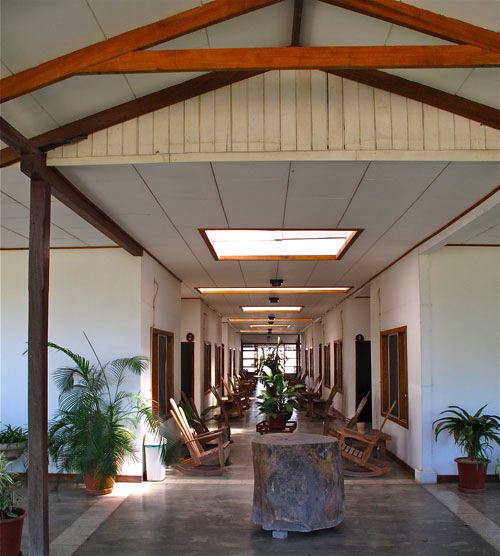
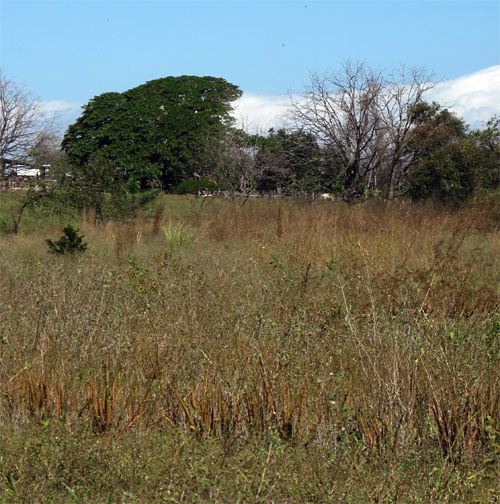
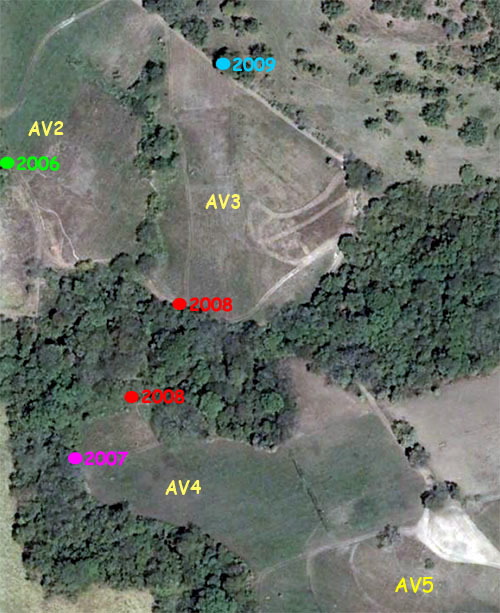
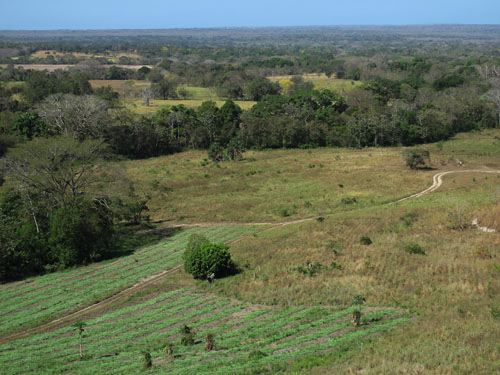

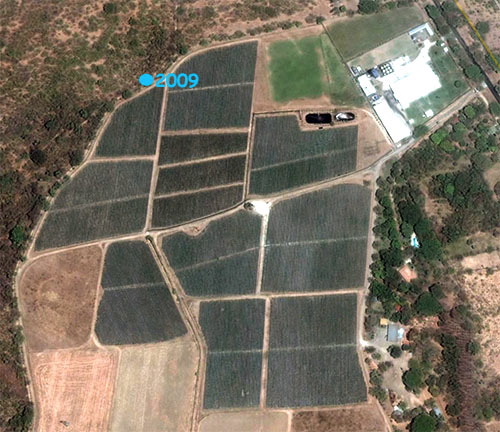
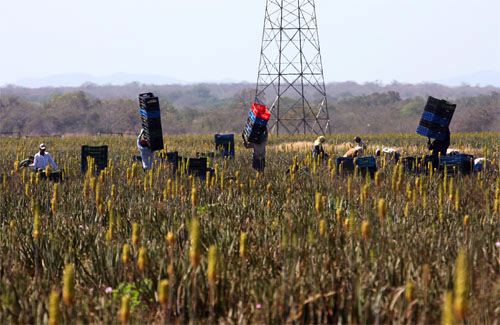
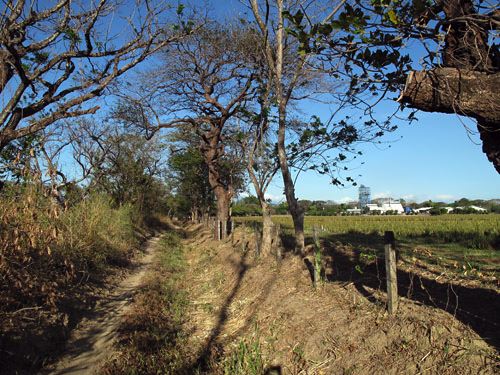
 By heading out early on 28 January we got to Pelón by 6 a.m. and started opening nets. Within 25 minutes we had our first Ruby-throated Hummingbird of 2010--a female undergoing wing and tail molt typical for late January on the wintering grounds. By 7 a.m. we had two more female RTHU, but things really slowed; by shut-down time at noon we had handled only five hummers--all females.
By heading out early on 28 January we got to Pelón by 6 a.m. and started opening nets. Within 25 minutes we had our first Ruby-throated Hummingbird of 2010--a female undergoing wing and tail molt typical for late January on the wintering grounds. By 7 a.m. we had two more female RTHU, but things really slowed; by shut-down time at noon we had handled only five hummers--all females. 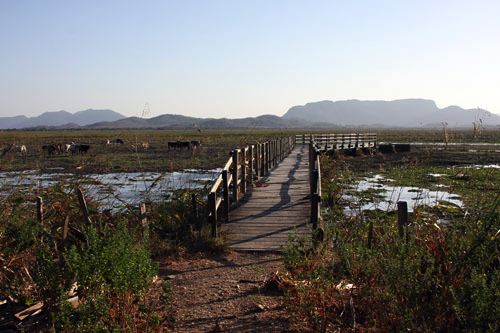

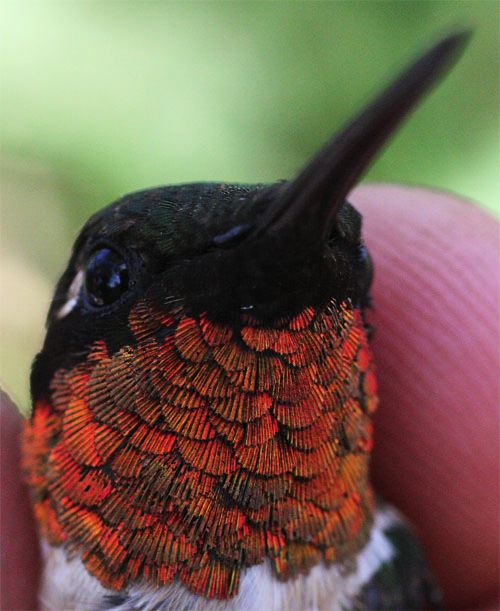

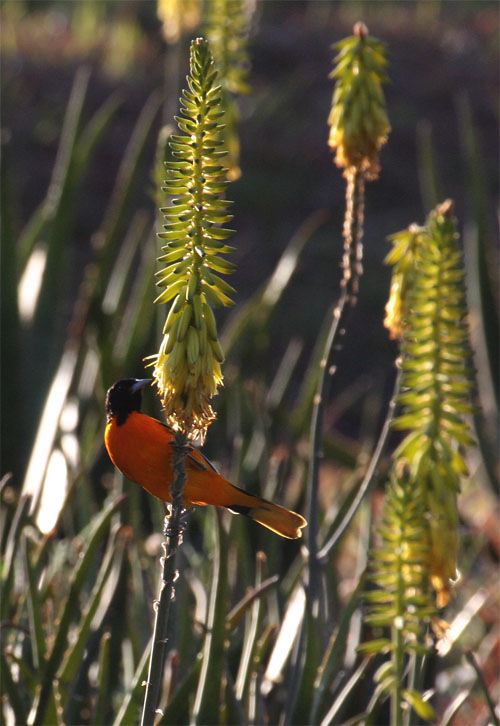
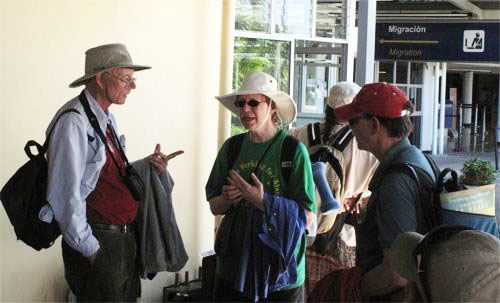
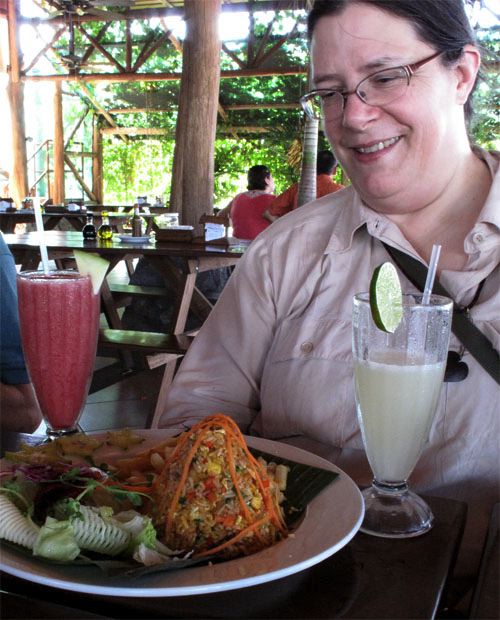
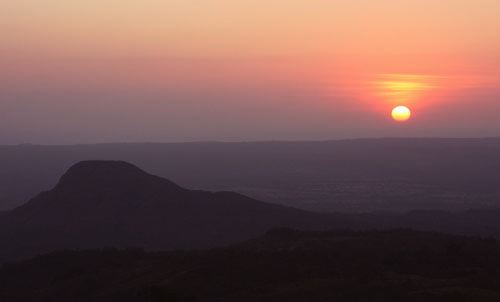
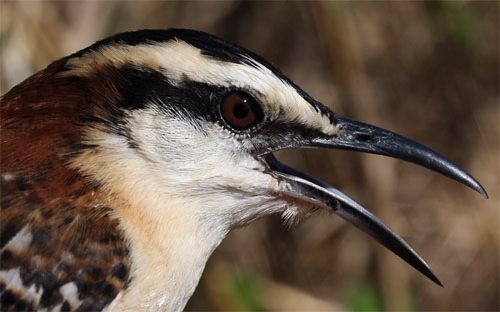
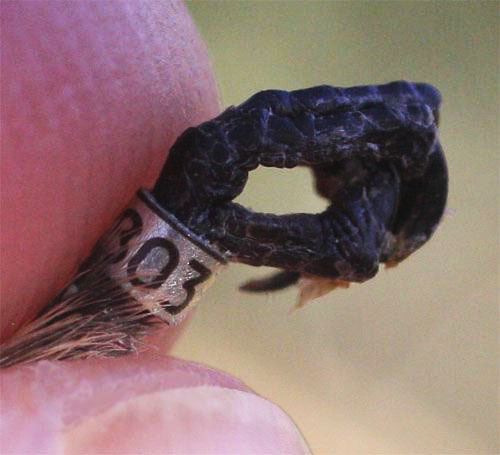
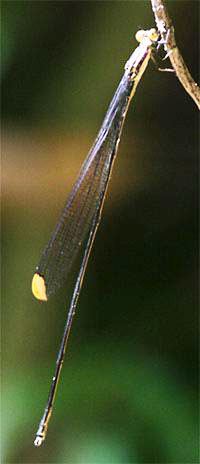 We closed nets a little early on 5 February so we could drive northward for an afternoon field trip to Santa Rosa National Park, reportedly the largest remaining tropical DRY forest in Central America. Most people who go to Costa Rica clamor to see its tropical RAIN forests in a much wetter region that lies primarily on the country's Caribbean side. The dry forest--which actually can be very wet during the rainy season--sees no real precipitation from November through April and has its own unique habitats and organisms. Trees and shrubs are either deciduous (dropping their leaves as a way NOT to lose precious moisture during the dry season) or evergreen (with thick, waxy leaves that RETAIN moisture). In the dry forest, it's quite interesting to see a completely leafless deciduous tree in full flower growing right beside a broadleaf evergreen. As Ernesto led us through the arid habitat, he pointed out birds, insects, and flora we hadn't seen in unprotected areas of Guanacaste. One of these was a huge damselfly with yellow wing tips, shown about actual size in the photo above right.
We closed nets a little early on 5 February so we could drive northward for an afternoon field trip to Santa Rosa National Park, reportedly the largest remaining tropical DRY forest in Central America. Most people who go to Costa Rica clamor to see its tropical RAIN forests in a much wetter region that lies primarily on the country's Caribbean side. The dry forest--which actually can be very wet during the rainy season--sees no real precipitation from November through April and has its own unique habitats and organisms. Trees and shrubs are either deciduous (dropping their leaves as a way NOT to lose precious moisture during the dry season) or evergreen (with thick, waxy leaves that RETAIN moisture). In the dry forest, it's quite interesting to see a completely leafless deciduous tree in full flower growing right beside a broadleaf evergreen. As Ernesto led us through the arid habitat, he pointed out birds, insects, and flora we hadn't seen in unprotected areas of Guanacaste. One of these was a huge damselfly with yellow wing tips, shown about actual size in the photo above right.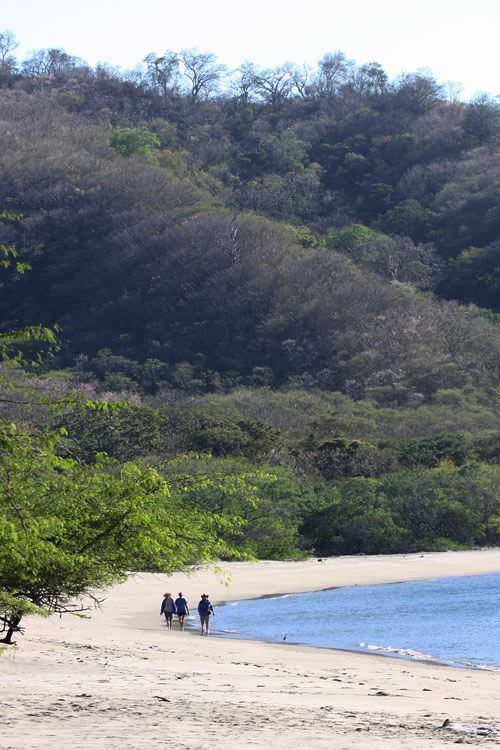
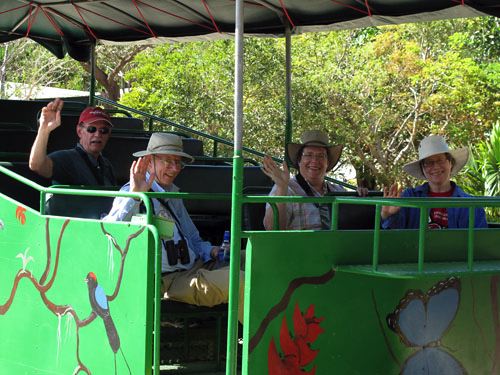

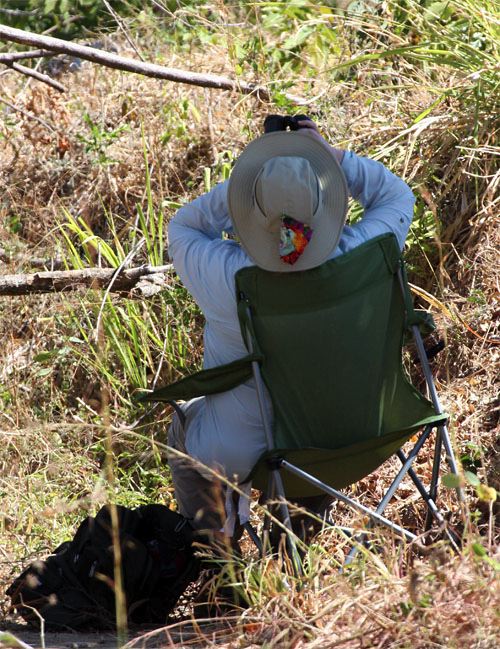
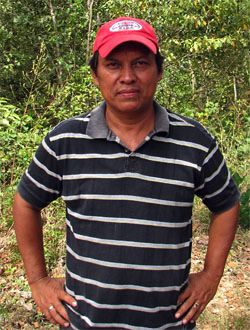 With nowhere to sell aloe, Franklin had been forced to lay off workers, and the weeds quickly took over. He said he understood the Pelón company would soon start buying aloe from fincas other than its own and that aloe farming would again become profitable.
With nowhere to sell aloe, Franklin had been forced to lay off workers, and the weeds quickly took over. He said he understood the Pelón company would soon start buying aloe from fincas other than its own and that aloe farming would again become profitable. 
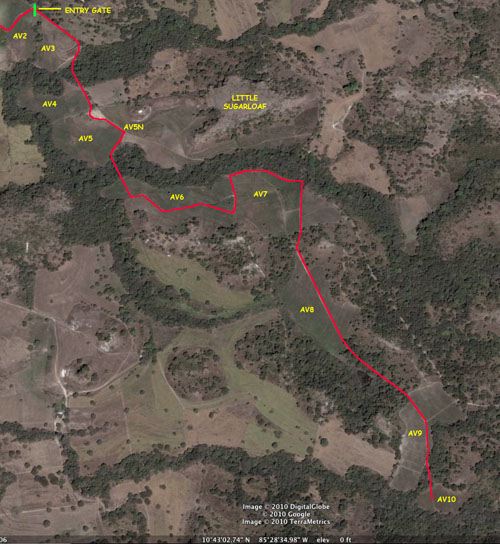
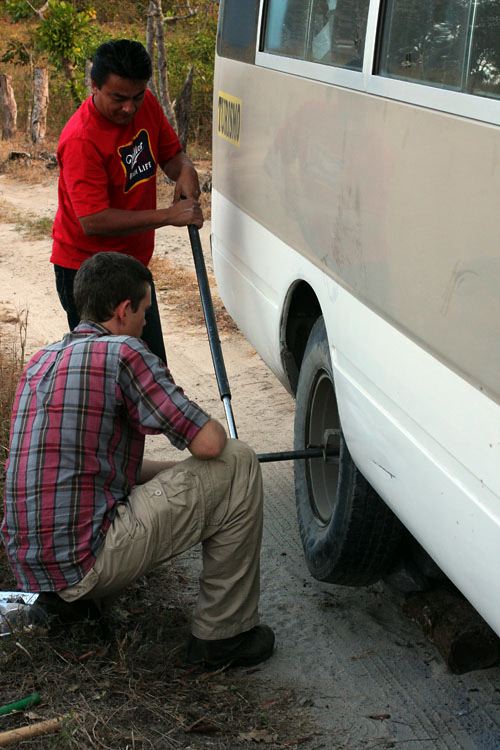

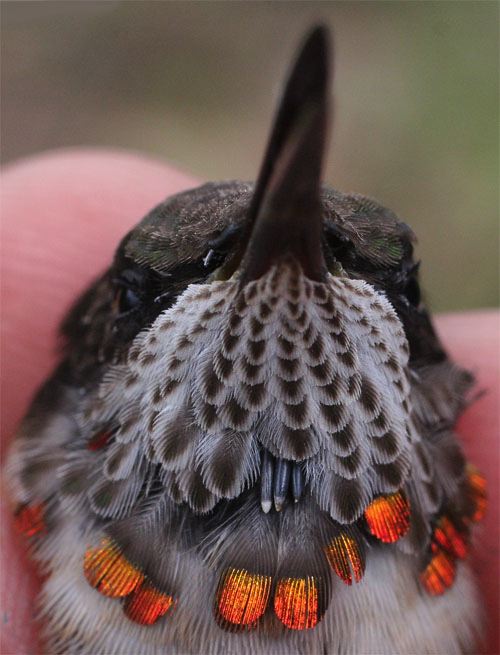
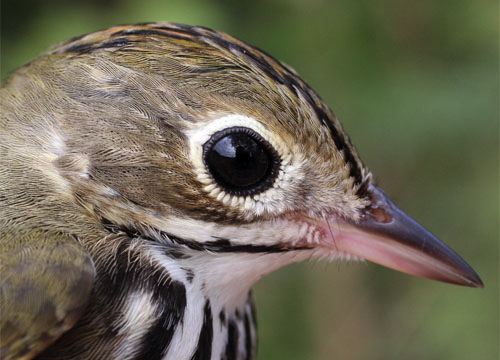
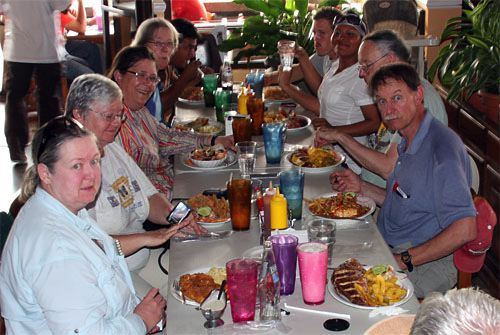
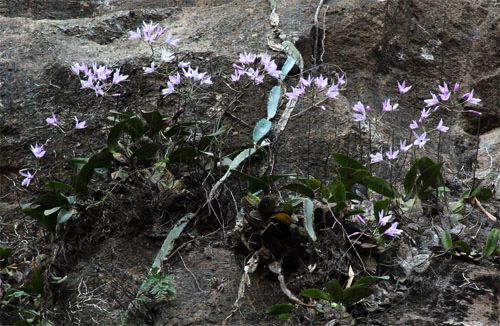
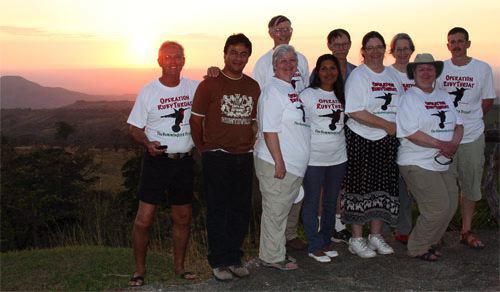
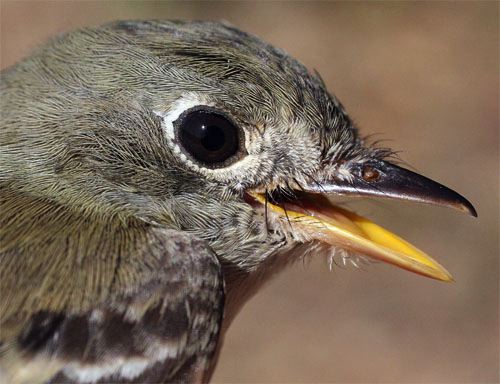
 Things really slowed down during the afternoon, however, and Ela observed local hummingbirds seemed to have figured out where our mist nets were and were flying over and around them. Net wariness does occur in wild birds, so Ela suggested we pull up stakes at AV10 and think about a different banding site for the following day.
Things really slowed down during the afternoon, however, and Ela observed local hummingbirds seemed to have figured out where our mist nets were and were flying over and around them. Net wariness does occur in wild birds, so Ela suggested we pull up stakes at AV10 and think about a different banding site for the following day. the former Navy fighter pilot and deep-thinking, laid-back organic shade-grown coffee farmer who designed our net stakes and the carriers that allowed us to transport net poles and other unwieldy field gear with Ernesto's car. This year, Juan Diego Vargas (left) was our sidekick, and he proved to be an inquisitive student, a great observer, and a real help in the field. We were most grateful for the assistance Juan and Ela provided--she, especially, for her conscientious watchfulness, for carefully extracting birds from the nets, and for painstakingly documenting our banding efforts with her new SLR camera (below). And, of course, without Ernesto's hard work and original discovery of hummers in the aloe fields, Operation RubyThroat wouldn't be in Costa Rica at all.
the former Navy fighter pilot and deep-thinking, laid-back organic shade-grown coffee farmer who designed our net stakes and the carriers that allowed us to transport net poles and other unwieldy field gear with Ernesto's car. This year, Juan Diego Vargas (left) was our sidekick, and he proved to be an inquisitive student, a great observer, and a real help in the field. We were most grateful for the assistance Juan and Ela provided--she, especially, for her conscientious watchfulness, for carefully extracting birds from the nets, and for painstakingly documenting our banding efforts with her new SLR camera (below). And, of course, without Ernesto's hard work and original discovery of hummers in the aloe fields, Operation RubyThroat wouldn't be in Costa Rica at all.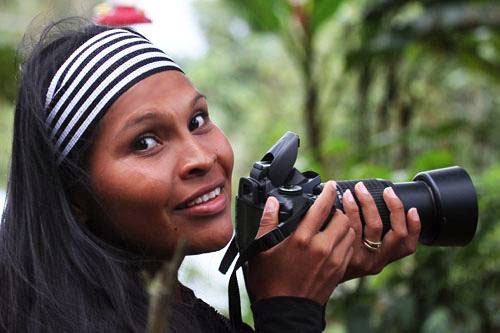
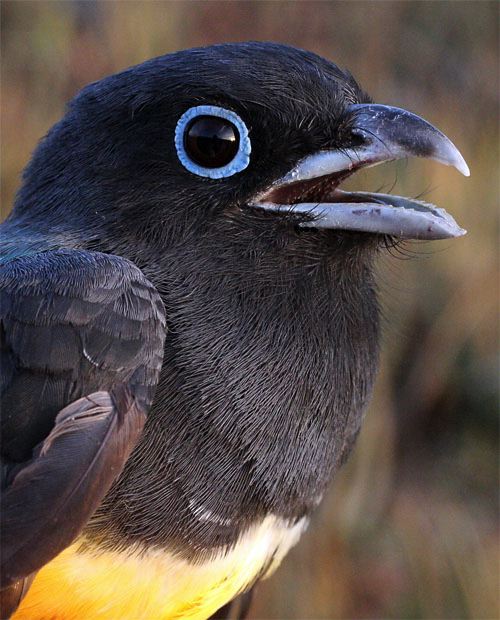

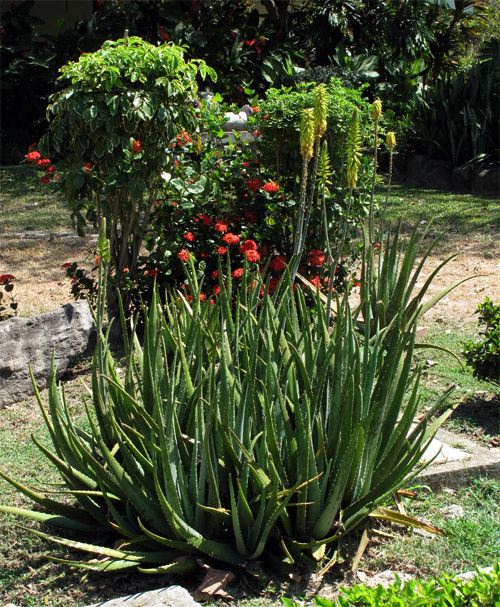
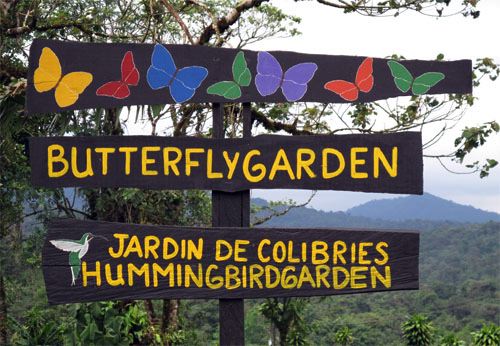
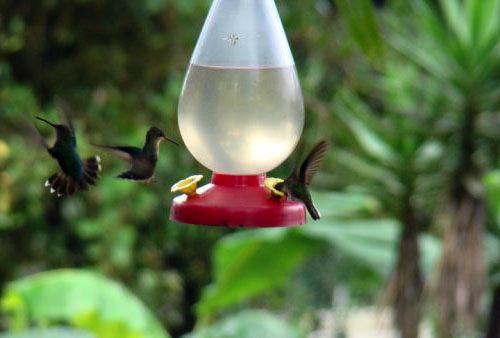
 and ultimately Paraíso, home of Finca Cristina--the Carman family's organic shade-grown coffee farm that produces Cafe Cristina. When we arrived after dark the finca was pitch black; seems an electrical transformer had blown that morning and the power company crew hadn't finished fixing it. We were greeted in ghost-like fashion by Ernesto's parents, by now old friends Linda and Ernie Carman Jr., and--being hungry after our long drive--we were most pleased Ernie was able to prepare a candlelight cheese sandwich dinner on a gas stove in the kitchen.
and ultimately Paraíso, home of Finca Cristina--the Carman family's organic shade-grown coffee farm that produces Cafe Cristina. When we arrived after dark the finca was pitch black; seems an electrical transformer had blown that morning and the power company crew hadn't finished fixing it. We were greeted in ghost-like fashion by Ernesto's parents, by now old friends Linda and Ernie Carman Jr., and--being hungry after our long drive--we were most pleased Ernie was able to prepare a candlelight cheese sandwich dinner on a gas stove in the kitchen. were kind enough to drive trip leader Bill to the airport in San Jose. There, after the requisite lengthy bear hugs, Bill boarded a plane for a flight to Atlanta, then Charlotte. Finally, in the wee hours of 15 February, it was home to Hilton Pond Center, bringing to an end another ground-breaking Ruby-throated Hummingbird field season in the Aloe Vera fields of Guanacaste Province, Costa Rica. See you there next year--if not before!
were kind enough to drive trip leader Bill to the airport in San Jose. There, after the requisite lengthy bear hugs, Bill boarded a plane for a flight to Atlanta, then Charlotte. Finally, in the wee hours of 15 February, it was home to Hilton Pond Center, bringing to an end another ground-breaking Ruby-throated Hummingbird field season in the Aloe Vera fields of Guanacaste Province, Costa Rica. See you there next year--if not before!

 Oct 15 to Mar 15:
Oct 15 to Mar 15: